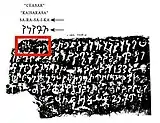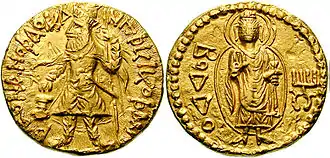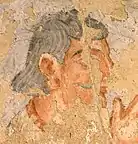Kanishka III
Kanishka III (Greco-Bactrian: κανηþκε Kanēške, Brahmi: ![]()
![]()
![]() Kā-ṇi-ṣka, Sanskrit: कनिष्क), was a Kushan emperor who reigned for a short period around the year 268 CE. He is believed to have succeeded Vasishka and was succeeded by Vasudeva II. He ruled in areas of Northwestern India.[2]
Kā-ṇi-ṣka, Sanskrit: कनिष्क), was a Kushan emperor who reigned for a short period around the year 268 CE. He is believed to have succeeded Vasishka and was succeeded by Vasudeva II. He ruled in areas of Northwestern India.[2]
| Kanishka III | |
|---|---|
| Kushan emperor | |
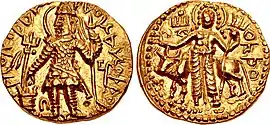 Coin of Kanishka III. Circa AD 267-270. Main mint in Taxila. Obverse: King Kanishka standing holding a standard, sacrificing over an altar; trident to left. Greco-Bactrian legend around ϷΑΟΝΑΝΟϷΑΟ ΚΑΝΗϷΚΙ ΚΟϷΑΝΟ
Shaonanoshao Kanishki Koshano "King of Kings, Kanishka the Kushan". | |
| Reign | c. 268 CE |
| Predecessor | Vāsishka |
| Successor | Vasudeva II |
Inscriptions
In an inscription dated to the "Year 41" (probably of the 2nd century of the Kanishka era) and discovered on the borders of the river Ara in Punjab, he qualifies himself as a Maharaja Rajatiraja Devaputra Kaisara Kanishka ("Great King, King of Kings, Son of God, Caesar, Kanishka), suggesting some awareness of the Roman Empire as Kaisara seems to stand for "Caesar", and names himself as the son of Vajheshka, identified as Kushan ruler Vashishka.[3][4][5] The inscription is rather worn and the reading Kaisara has been doubted, especially since no other mentions of this title are known from Kushan sources.[6]
| Kushan Empire 30 CE–350 CE | ||||||||||||||||||||||||||||||
|---|---|---|---|---|---|---|---|---|---|---|---|---|---|---|---|---|---|---|---|---|---|---|---|---|---|---|---|---|---|---|
|
||||||||||||||||||||||||||||||
Coinage
No definite coins are known of him, as the "Kanishka" named in the coins is not differentiated. Only workmanship and graphical style in relation to other known rulers, tend to suggest attribution to this later Kanishka.[9]
Notes
- CNG Coins
- Frye, Richard Nelson (1984). The History of Ancient Iran. C.H.Beck. p. 344. ISBN 9783406093975.
- Mario Busssagli, "L'Art du Gandhara", p229
- A Comprehensive History Of Ancient India (3 Vol. Set). Sterling Publishers Pvt. Ltd. 2003. p. 134. ISBN 9788120725034.
- Rezakhani, Khodadad (2017). From the Kushans to the Western Turks. p. 203.
- Rosenfield, John M. (1967). The Dynastic Arts of the Kushans. University of California Press. p. 58.
- Konow, Sten (1929). Kharoshthi Inscriptions With The Exception Of Those Of Asoka. p. 163.
- Konow, Sten (1929). Kharoshthi Inscriptions With The Exception Of Those Of Asoka. p. 163.
- Rosenfield, John M. (1967). The Dynastic Arts of the Kushans. University of California Press.
| Preceded by Vasishka |
Kushan Ruler | Succeeded by Vasudeva II |
- From the dated inscription on the Rukhana reliquary
- An Inscribed Silver Buddhist Reliquary of the Time of King Kharaosta and Prince Indravarman, Richard Salomon, Journal of the American Oriental Society, Vol. 116, No. 3 (Jul. - Sep., 1996), pp. 442
- A Kharosthī Reliquary Inscription of the Time of the Apraca Prince Visnuvarma, by Richard Salomon, South Asian Studies 11 1995, Pages 27-32, Published online: 09 Aug 2010
- Cribb, Joe; Donovan, Peter (2014). Kushan, Kushano-Sasanian, and Kidarite Coins A Catalogue of Coins From the American Numismatic Society by David Jongeward and Joe Cribb with Peter Donovan. p. 4.
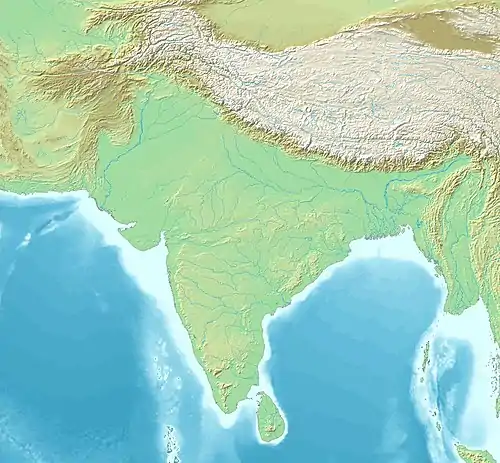
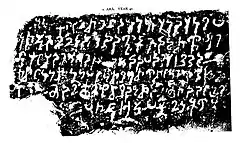
.jpg.webp)
